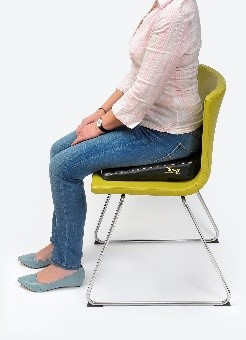By Nancy Alexander, PT
There is something very important to you as you live your life and move, and that is posture. What is posture and why is it so important? Posture is body position. It is one part of your body and its relationship to another part of your body. It constitutes joint positions, angles, soft tissue length, and tension among and between structures. It’s really quite fascinating. Let’s take a further look and relate it to your everyday activities. Trust me. It’s worth it.
Posture can be in either a static state or a dynamic state. Static posture means there is limited to no movement of your body. Sitting, for example, is considered a static posture. Dynamic posture is characterized by constant motion. An example of this includes walking or even lifting an object off the floor. You are likely in a seated position right now. Are you sitting upright or have you slid down lower or slouched, in your chair? Is your chair hard or soft? Is it high or low? Are your feet on the floor? Or are you standing up? Perhaps you have a standing desk, so you don’t have to sit so often. Are you sitting on a stability ball? Some people do.
Posture matters. It matters because when it’s not right, you can hurt. If you continue to ignore the signs, then damage can occur. Pain is one of the main reasons people see a physical therapist. It is the most common diagnosis I have seen on a prescription throughout my entire career. And often, it is due to poor posture. The good news is if we catch poor posture early enough, we can correct it with minimal to no damage. With a thorough evaluation, we can identify the cause of pain and start to correct it right away. Before we discuss the 7 tips, let’s briefly understand the anatomy. A little knowledge goes a long way.

We all have natural curves in our spine (See the above illustration). At the neck, there is an inward curve. As we travel lower, the thoracic spine has an outward curve. Keep travelling down, and the lumbar spine has an inward curve, followed by an outward curve made by the sacrum. We all have different size curves that can change as you age. You may have a larger lumbar curve than someone else. Someone may have what’s called a flat back at the lumbar levels, which means there is little to no curve. We’re all different, but we can respect our own curves and try to keep these curves as close to normal as possible during our daily activities. This applies to both static and dynamic posture.
(Above is an excerpt from Nancy’s new book, “Get UP! Defy Aging with Movement.”)
7 Tips
Every one of the tips below are intended to preserve your natural curves. It is really that simple.
- Sit with support at the small of your back with a pillow or towel roll to help support your spine. Make sure feet are well supported and not dangling.
- Sit with hips at the height of your knees or slightly higher for improved posture. Don’t forget to do this in your car too with a folded towel or small wedge pillow. (See picture below)
- Place one foot in the cabinet below your sink when standing in the kitchen whether washing dishes or doing prep work at the counter. If that is not appropriate, place a yoga block flat on the floor right up against the counter on which you can place one foot. Alternate feet too if you are there long enough. This will help neutralize the arch in your low back and make you more comfortable. Please note: You can also do this in the bathroom when brushing your teeth or doing other grooming and self-care tasks.
- If you perform a lot of seated desk work, place a small stool under your desk on which to place a foot. This effect is the same as noted in #3 above. Feel free to alternate legs as desired.
- When sitting and using your computer, try to position your monitor so that the top of it is at eye level. This will help your upper back to be in proper position. (See picture below)
- When lifting, use the hip hinge method of picking up items in front of you or off the floor. This will not only help keep your natural curves where they should be, it will lessen stress on your back. You will rely on your big muscle groups to do the task thus reducing risk of injury. (Check out how to perform the hip hinge HERE. )
- If you’re a side sleeper, try putting a small pillow between your knees. This will help align your spine more naturally and can even help reduce hip pain. Don’t worry if you lose this position while sleeping. The more time spent with the pillow, the better. Feel free to experiment with different size pillows to find what works best for you.


Proper posture helps decrease pain as well as damage to joints and soft tissue, and that’s a great investment to make for your body over the long term. Start now and follow these tips to improve your posture today.
All photos/illustrations provided by istockphoto.com.
Copyright ©2021 Nancy Alexander. All rights reserved.
